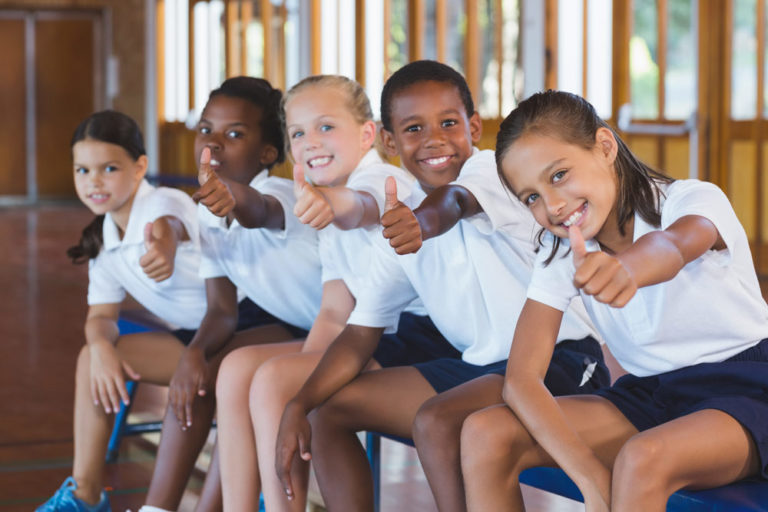Anti Bullying Guide for Schools
This anti bullying guide is designed to be a useful resource for teachers, families and other members of the community, who all play a part in promoting positive behaviour in schools.
Bullying can have a lasting impact on wellbeing and is a major concern for students, families and school staff. This anti bullying guide provides an overview of bullying, including what it is, how to prevent it, strategies for creating a positive school climate, and how to implement effective anti bullying programs in Australian schools. Our guide is designed to be a useful resource for teachers, families and other members of the community, who all play a part in promoting positive behaviour in schools.
Read along or use the navigation to jump ahead.
To learn about our bullying programs for high schools and primary schools
Table of Contents
1
What is bullying?
There are many different views on bullying, including what it is and what it isn’t. Students’ views about what constitutes bullying are often different to the views of teachers, parents and other adults. There is general consensus amongst academics and policy-makers, however, about what defines bullying.
The national definition of bullying for Australian schools involves three main features: 1) a misuse of power in a relationship; 2) behaviours that are ongoing and repeated, and 3) behaviours that can cause harm. Bullying can happen in person, such as at school or in the community, and can happen online (‘cyberbullying’). The national definition includes bullying that happens both online and offline.
Bullying can include verbal behaviours such name-calling or insults based on physical characteristics, race, sexuality, culture, religion or other personal attributes. It includes physical bullying, such as hitting, shoving and damaging or stealing property. It can also include social behaviours such as consistently and deliberately excluding someone, or sharing information or images that could be harmful or embarrassing. Bullying can involve behaviours that are obvious to others (‘overt’ bullying) or more subtle behaviours such as threatening looks, gestures or exclusion (‘covert’ bullying). Bullying is not an argument or disagreement, or a one-off instance of mean or aggressive behaviour; however, these things can still cause significant distress and harm.
Establishing a common understanding of bullying amongst students, staff and families is one of the first steps towards preventing bullying in Australian schools.
2
Why is bullying prevention important?
Bullying is a common problem amongst primary and high school students and can have a lasting impact on psychological wellbeing. Bullying. No Way! estimates that approximately one in four students experiences bullying in person, and around one in five students experiences bullying online. However, these figures should be used with caution.
Due to the significant variation in research design and methodology, the student populations being studied and the types of bullying being investigated, a single prevalence figure has not been established. The prevalence of bullying also varies significantly across age, student characteristics and the time of year, and is difficult to estimate because many students are reluctant to report it.
According to Bullying. No Way!, prevalence figures from research may have limited value for schools. Instead, it is more useful for schools to investigate and understand the issue of bullying in their own communities. This will help staff to develop targeted and responsive anti bullying programs that are effective for their school. This involves establishing a shared definition of bullying, regularly monitoring the prevalence of bullying, surveying students, fostering positive student-teacher relationships and establishing effective reporting processes.
Bullying has been linked to a range of negative health outcomes for children and young people. A 2018 study of Australian primary school students, for example, found that students who experienced frequent bullying were more likely to experience internalising symptoms, such as symptoms of anxiety and depression, than those who did not report frequent bullying.
Bullying also incurs significant economic costs to society, costing an estimated $2.3 billion per individual school year group, with impacts on productivity, chronic health conditions and ongoing bullying and violence that can continue well into adolescence and adulthood.
Some students are at greater risk of bullying than others, including those who identify as LGBTIQA+, culturally and linguistically diverse students, Aboriginal and Torres Strait Islander students and students with a disability. The mental health impacts for these vulnerable groups may be greater than for other students, as they often face a number of additional challenges during their schooling.
Overall, bullying is highly prevalent and comes with significant health and economic costs to individuals, families and communities. Implementing comprehensive and effective anti bullying programs is therefore a key priority for Australian schools.
3
How can schools prevent and respond to bullying in their community?
Bullying does not occur in a vacuum. Bullying is a social issue that is influenced by the relationships between people, values, social norms and the broader cultural context. This ‘social-ecological’ perspective can help schools more effectively prevent bullying by working with the whole school community and building a safer and more positive school climate.
School climate has been identified as one of the most important factors for addressing bullying and improving student wellbeing more broadly. School climate has been defined as “the quality and character of school life” and “reflects norms, goals, values, interpersonal relationships, teaching and learning practices, and organizational structures.”
School wide bullying prevention programs can be effective for reducing and preventing bullying behaviours and victimisation, and improving school climate. The NSW Government Centre for Education Statistics and Evaluation conducted a review of the literature, and identified some of the common elements of effective anti bullying programs in schools:
- A holistic, whole-school approach: The research suggests that the most effective programs are those that involve all members of the school community, including parents and carers, and foster a culture of student wellbeing, positive relationships and a norm of diversity and inclusion. An anti bullying policy is important for developing a shared understanding of the school’s response to bullying, including clear reporting procedures.
- A focus on social and emotional learning (SEL): Research indicates that classroom-based social and emotional learning (SEL) programs are an important component of anti bullying programs for schools. Social and emotional learning (SEL) is generally focused on five interrelated areas: self-awareness, self-management, social awareness, relationship skills and responsible decision-making. Teachers can promote positive behaviours in the classroom by teaching self-regulation, empathy, perspective-taking and social problem-solving skills. Learn more about social and emotional learning (SEL) on our Student Wellbeing Guide for Schools.
- Education about appropriate responses to bullying: Research has shown that peer bystanders play an important role in the bullying process. Anti bullying programs are enhanced by emphasising how bystanders can stop bullying and their role in creating a safer and more positive school climate. Programs should target the group dynamics of bullying behaviour by encouraging positive and active bystander behaviour (or ‘upstander’ behaviour). Bystander training interventions, peer support programs and the analysis of bullying scenarios can help raise awareness of the role of bystanders and provide safe strategies to intervene and support those who are victimised.
- Support and professional development for school staff: Teacher and staff training is an important component of effective anti bullying programs. Ongoing professional learning should be provided to pre-service and in-service teachers, to help build their capacity and confidence in responding to bullying and cyberbullying incidents, and develop their understanding of the factors contributing to bullying in Australian schools.
- Systematic program implementation and evaluation: The most effective anti bullying programs are those that are implemented carefully, deliberately and systematically, and are regularly monitored and evaluated by school leaders. While school wide bullying programs can be time consuming and complicated to implement, the research shows that this is time well spent.
There are a wide range of anti bullying programs and frameworks for schools, and the process of selecting a program can be overwhelming. The STEPS decision-making framework has been developed by Bullying. No Way! to help schools select evidence-based programs that meet their specific needs and goals.

Below are some additional bullying prevention strategies for schools:
- Implement a school wide cyber safety program to prevent cyberbullying and promote positive and respectful behaviour in online environments. Learn more about online safety education in our Cyber Safety Guide for Schools.
- Implement a school wide mental health program to enhance resilience, coping skills and help-seeking behaviour in response to bullying. A recent study found that mental health education in schools is associated with lower levels of bullying and violence amongst students. Learn more about resilience and mental health education in our Student Wellbeing Guide for Schools.
- Participate in school wide anti bullying events such as Harmony Week and the National Day of Action Against Bullying and Violence (NDA). Stay up-to-date with the latest Australian anti bullying events on our blog.
- Create a supportive culture in your school and encourage students to look out for one another by using the R U OK? education resources. Learn more about our partnership with R U OK? and how your school can get involved on our R U OK? page.
4
How can theatre in education support your school’s anti bullying program?
The arts can make a valuable contribution to the conversations around bullying in your school. Live theatre allows students to experience different scenarios, develop empathy skills and experiment with a range of anti bullying strategies in a safe, supportive environment.
Theatre and the arts can help to bring the issue of bullying to life and facilitate further learning in the classroom. For example, there is evidence that the use of drama activities can play a role in reducing bullying behaviour, and that using video education material as part of a social and emotional learning (SEL) program can help to reduce bullying victimisation.
Live productions for schools, such as those offered by Brainstorm Productions, provide a fresh voice to the discussions around bullying and bystander behaviour at your school. Brainstorm’s performances support the social and emotional learning material being covered in the classroom and offer a starting point for further discussions and activities.
We offer a 50-minute live performance, presented by positive young role models and developed by education and mental health specialists. The performance is followed by a Q&A with the performers and is supported by a series of curriculum-aligned lesson plans and classroom resources.
The programs are designed to compliment your school’s existing school wide bullying prevention strategy, using a dynamic, creative and experiential learning approach.
5
More anti bullying and student wellbeing resources
- Bullying. No Way! provides evidence-based information and resources for students, parents and teachers to prevent bullying in Australian schools.
- The eSafety Commissioner provides up-to-date information on cyber safety and cyberbullying for Australians of all ages. Their dedicated pages for children and young people offer age-appropriate information about the issues and where to go for support. There are also resources for educators and parents. The eSafety Commissioner also has a cyberbullying reporting tool to support young people and their families who have experienced serious cyberbullying.
- Headspace provides young people aged 12 to 25 with physical and mental health support in the form of online, telephone and face-to-face counselling. The website also provides youth-friendly information about mental health and wellbeing issues, including bullying and cyberbullying.
- Reachout.com has lots of information for young people about mental health, wellbeing and how to cope with bullying.
- Kids Helpline offers counselling, support and information to children and young people aged 5 to 25 years. The website provides age-appropriate information about a range of wellbeing topics, including bullying and cyber bullying.
Watch our video about Kids Helpline with an Auslan translation below:
Did you find this guide helpful?
Check out our other free student wellbeing resources for schools:
Join Us
Follow us on Facebook for updates on our anti bullying programs and other anti bullying resources.


